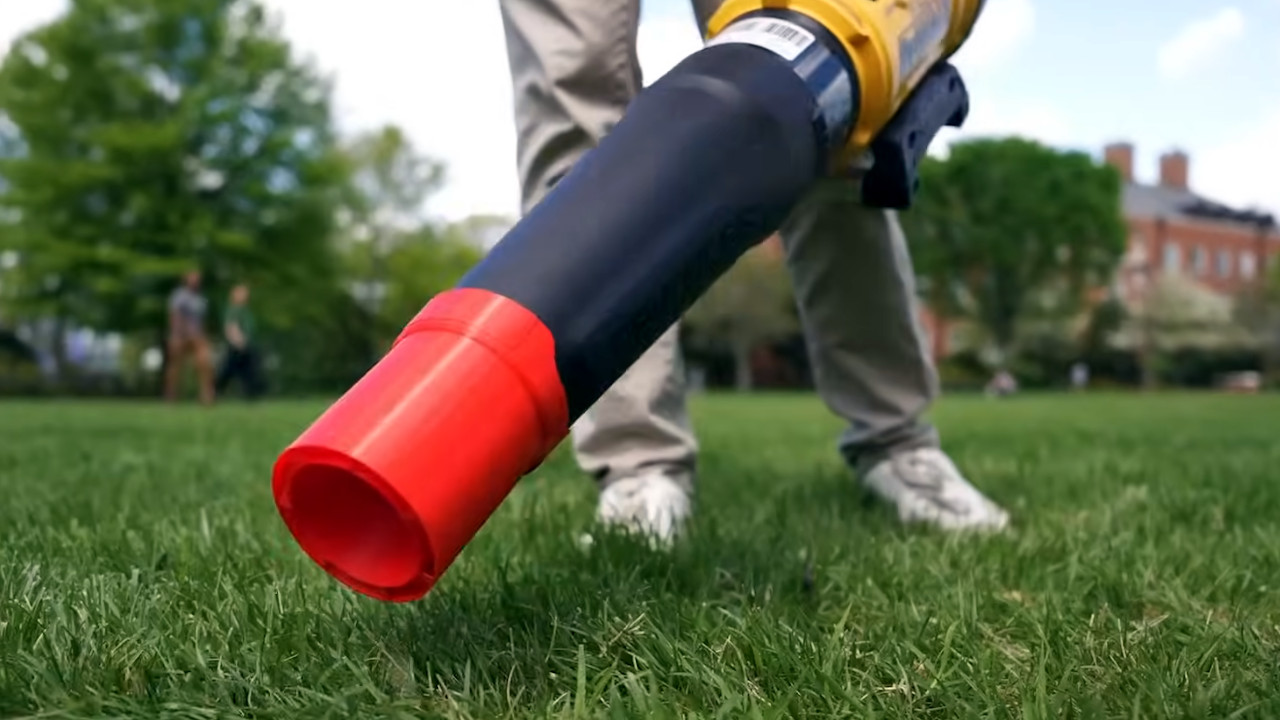- cross-posted to:
- [email protected]
- cross-posted to:
- [email protected]
was posted 3 days ago in /c/Technology, here :
https://lemmy.world/post/15468260
what they did :“Our product takes in a full blow of air and separates it,” said team member Leen Alfaoury. “Some of that air comes out as it is, and part of it comes out shifted. The combination of these two sections of the air makes the blower less noisy.”
… “It ultimately dampens the sound as it leaves, but it keeps all that force, which is the beauty of it.”
Their design cuts the most shrill and annoying frequencies by about 12 decibels, which all but removes them, making them 94% quieter.
about 12 decibels, which all but removes them, making them 94% quieter.
This “conversion” from decibel to per cent is more than ridiculous.
Why? dB is logarithmic so it’s difficult for people to picture how loud something is, if that’s the only number given.
And so are our ears. That’s why we use db. So 12db is not perceived by us to be 94% quieter.
So its 94% less sound because this seems sound calculated -12db in % with conventional formulas?
How would we describe perceived sound exactly, not many people can imagine something when given a db value? Maybe we should?
When loudness is described there’s often lists with examples of things with their typical loudness specified in dB, so you can compare against things you may have heard.
See the image chart here
https://decibelpro.app/blog/decibel-chart-of-common-sound-sources/
I have done a lil research but what i needed was this site. Great resource, maybe even coolguides material.
deleted by creator
Well, 93.7% to be more exact. Did you recalculate it yourself the same i did ?
Your calculation was about energy. But the calculation of energy is next to useless when you are trying to compare two different noises. You need to care about perception.
The perception of noise is quite complicated. But as a rule of thumb: when some noise changes by -10dB, then you hear it about “half as loud”.
Source: I have a university degree in acoustics.
So for the reduction of -12dB here, it will be perceived as “nearly half as loud”. Very different than the “94%” is suggesting.
It’s also only 2db overall, the one frequency they dropped that much.
We agree that the -12dB is what’s important for human hearing … Now, you may agree that the 94% reduction is what counts regarding engineering // fabrication // design.
We agree that the -12dB is what’s important for human hearing … Now, you may agree that the 94% reduction is what counts regarding engineering // fabrication // design.
-2db* and 37%*
Why are you perpetuating the wrong information?
The snippet quoted in the original comments and referenced in subsequent comments refers specifically to the decibel reduction of the frequencies being targeted by the invention, not the volume of the overall sound.
Is it? Because the next sentence in the paragraph (and the only sentence missing in the quote) is the overall sound reduction. Which is far more important and far less misleading than saying 12db and 94% quieter.
Its intentionally misleading to deceive people, and than the general public incorrectly defends it, this is you.
The team reduced the overall leaf blower noise by about two decibels, making the machine sound 37% quieter.
You omitted the most important data, it’s 2db overall, not 12db.
So your own “recalculation” isn’t even in the right ballpark as the correct answer.
Its people that misinterpret the information and perpetuate it like you are doing here that makes these look far better than they actually are.
Just saying it doesn’t decrease the power is a bold claim without providing anything technical to support it.
I’ve read multiple articles and videos and yet this very crucial information is intentionally not included.
The claims are false, you can’t suppress or mute something with a tradeoff, unless they have somehow magically figured out physics anomalies. Would love to see some proof of this claim it doesn’t decrease power output.
Are you saying novel mechanical engineering designs are impossible? That the mechanism of a leaf blower is so near perfection, that a well funded team of 4 mechanical engineering students could not, without VIOLATING THE LAWS OF PHYSICS, have simply found a better mechanism?
I agree with your “show me the numbers” critique, but I find your complete disregard of what may be a better answer without any data at all to be equally foolhardy.
He has a point though… OVERALL noise was only suppressed 2db. It’s only 12db in a specific frequency. EVERY article has more or less ONLY stated the 12db value. It seems more and more these days that you just have to assume that the article headline is at best mostly false, or obscenely misleading.
2db overall… is kind of fucking pointless. I mean… as someone afflicted with hearing problems I know that every db matters. But all this hubbub for something that should just be found, then implemented without all this fanfare… the general public will not care about this, yet I’ve seen 3 articles on it for some reason.
And most normal people don’t understand the logarithmic nature of the db scale anyway. Every 3 db is technically a doubling in power. But it takes 10db for our perception to halve/double.
Because leaf blowers are fucking annoying and we need hope
Taking out the high-pitch whine will make them much more bearable. It’s a student project, they did well. This isn’t groundbreaking Noble-prize stuff, but it doesn’t deserve all the hate it’s getting here either.
Agreed. Being in the house and having the shrill component of the blower removed would greatly be appreciated.
I did a student project for server room HVAC fans being annoying back in uni, targeted reduction in those annoying or peak frequencies was a totally acceptable outcome as to not disturb operators (was for a simulated patient in the attached hospital). I’m not an acoustic engineer, so obviously take what I’m saying with a grain of salt (did do a lot of safety and risk work though), making things less annoying is perfectly valid if they’re not already harmful to your hearing in the first place.
What’s cool to me is that it’s just printable, so in theory super accessible and anyone could iterate on it if they desired (assuming it gets open sourced)
but it doesn’t deserve all the hate it’s getting here either.
I’m not sure I said anything hateful here… I cited facts from the actual paper and described discontent with the articles, specifically the headlines.
The hate is for making a pretty obviously false claim about no power loss. Increasing or even decreasing the exhaust length will affect performance. So for them to add 8” and claim there is no loss of power is quite frankly an outright lie. So it’s being called out, and yet people are defending the asinine claim, it’s hilarious and very concerning as well.
People are also focusing on the wrong information, the total db was reduced by a paltry 2db, not 12db like what’s being talked about.
So they provide sound data that is misleading, and make a claim about power and not provide the data. This just reads marketing piece instead of anything on the actual tech.
They also run between 60 and 100dB, so knocking that down to 48 and 88dB respectively is fucking useless
I am saying every single one of these claims have never wound up being actually true since they go against the very nature of physics. Yet people perpetuate the claims and defend them without the supporting data.
So to not provide the data for one claim, while providing the data for another is only done to mislead from the truth.
Sorry for not accepting what they say at face value since it goes against multiple things.
never wound up being actually true since they go against the very nature of physics.
This is an incredibly wild statement when you have no data on the device’s construction or operation.
Youre complaining about a lack of data then making wild assumptions about it with no data.
Not exactly a good scientific method here, mate.
It’s a wild statement to claim it doesn’t reduce power when even increasing the length of the discharge tube would affect its performance, and they’ve added a good 8”. Every time like this comes out without the data to back it up, it’s always false, everytime. If it wasn’t the data would be provided now wouldn’t it? Even just showing the CFM data would be enough, but they purposely omit it.
The fact that they purposely omitted data that they have is extremely concerning, it’s not a bold claim say it’s obviously false. It’s bold to claim something like that that goes against what we already know about physics.
I am sorry you are eating up this “marketing”, it’s why products like this are even sold, it’s hilarious, the amount of people defending this asinine claim is honestly quite shocking, especially on a community like this.
Not exactly a good scientific method here, mate.
Uhh… I’m not the one making claims that goes against common knowledge of aerodynamics and then not providing that data. So sure, wanting someone to prove their claim makes me bad at scientific method…?? Maybe the people defending bullshit claims are the ones you should be calling out, oh wait that you yourself. Give you head a fucking shake lmfao.
You’re right to be sceptical until more data is presented, but saying no claim of progress is ever true is quite obviously a gross misrepresentation of our current reality. You are doing this on digital devices interconnected with millions of users ar staggering speed and latency. Every part of which are scientific claims.
Every claim where they omit the actual data to support the claim is never fully true. Provide the CFM testing data they must have to even make that claim.
There is no valid reason to omit that data unless to mislead.
Unfortunately I don’t agree.
Good reasons to omit details include brevity, legibility, pedagogy and scope.
Showing the supporting evidence for all steps in an evidence chain is simply not feasible, and we commonly have to accept that a certain presupposed level of knowledge as well as ambiguity is necessary. And much of the challenge is to be precise enough in the things that need precision.
They provided the DB data so your argument for all of those reasons is invalid. They could have easily spent a single sentence providing the CFM data. So no, not a single one of those reasons is valid to omit 6 words.
They made a claim, they didn’t need to mention the power claim, but they did. They should have omitted the claim itself using your logic, instead of the supporting data. The argument is flawed itself.
and we commonly have to accept that a certain presupposed level of knowledge as well as ambiguity is necessary.
Like knowing making a discharge tube longer or shorter affects its aerodynamics….? So we know the claim is false already…? Their ambiguity is meant to mislead people with zero working knowledge of the subject… anyone with any experience will see its flaw immediately.
There’s a relevant physics anomaly called a Helmholtz resonator, or more broadly waveform interference.
Destructive interference is a thing. The energy of the vibrations doesn’t go away, however you CAN shift that energy into different frequencies and destructive interference done correctly will effectively shift it into so high frequencies that the vibrations are better compared with heat than with sound (what is heat convection anyway if not extremely high frequency sound? :)
Heat is electromagnetic radiation - photons, sound is mechanical displacement - phonons.
They mostly propagate the same due to being waves, in most other respects they are very different.
Heat convection is an entirely separate process where heat radiation is aided by the movement of the surrounding medium. Where it would otherwise heat up it’s environment, convection keeps the environment from heating up. Compare coffee in a thermos (very little convection) to a cup you’re blowing on (significant convection); more air movement - more cooling.
Also, destructive interference does not at all work like that.
Maybe a more useful analogy could be that waves have like walking animations, where in part of the animation they go up, and in another part they go down. Destructive interference happens when a wave in its’ “up” phase crosses a wave in it’s “down”, meaning the resulting movement looks like nothing. The waves don’t however interact in any way, and will continue on their way and on their own animation cycles.
The shifting and heating parts are technically true but require very specific circumstances, enough so that I’m more prone to believe it’s another misunderstanding of the physics behind this. But I’ll give you the benefit of the doubt.
Even increasing or decreasing the length of the discharge tube will change its power and CFM and they’ve added 8”. There is no way the aerodynamics and the overall performance isn’t affected.
You being downvoted is pretty crazy… Your statement is valid
12dB is literally nothing in reduction when the lawn dudes are blasting 60-100db
Decibel scale is logarithmic, which means 10db change is reducing perceived volume by half.
No. It means the sound energy is dropped by half. Our audio perception is also logarithmic however. It’s why we use db.
Almost. a 10db change is a 10x difference in power and roughly 2x difference in perceived loudness
Except if you read the information its only actually a 2 db decrease…
12 dB is a pretty decent reduction if your goal is hearing protection, 100->88 is also bringing it to something that absolutely needs hearing protection to something that’s borderline acceptable for an 8 hour shift depending on your local laws, mine say 4 hours but still, way more comfortable to use.
The team reduced the overall leaf blower noise by about two decibels, making the machine sound 37% quieter.
It’s an insignificant 2db, I don’t know why buddy didn’t provide the relevant information.
Reading the article, reducing the shriller frequencies by 12db is still pretty nice, looks like it’s designed for electric blowers which are already way quieter than gasoline powered ones, already generally in the hearing safe range. 2db overall should still be noticeable though, be generally less annoying.
Eh, I’ll take it though. I live in a fairly quiet part of town but the street has gotten pretty busy in the last could of years. And visually, I guess the street seems to open up making drivers get… spicy now and then. The fucking motorcycles, man. These noisy fucking middle-aged infants making 130 decibels while only going 15mph make me see red. I’d gladly take the lawn equipment noise.
The team reduced the overall leaf blower noise by about two decibels, making the machine sound 37% quieter.
It’s an insignificant 2db, I don’t know why buddy didn’t provide the relevant information.
Decibels are a logarithmic scale, so it scales exponentially. Because of this, reducing by just ten is actually very significant and would reduce the perceived volume by half, and would reduce the actual sound pressure even more than half.
The team reduced the overall leaf blower noise by about two decibels, making the machine sound 37% quieter.
It’s an insignificant 2db, I don’t know why buddy didn’t provide the relevant information.
If it were me that designed this, I would license out the design for manufacturers to use in their production models instead of making some kind of attachment that is unlikely to work on all models. That seems much more likely to achieve the goal of reducing noise from leaf blowers long term. Get like 3 manufacturers on board that could even charge a premium, and you have reduced the noise potentially forever while still making a tidy profit.
It was a collaboration with the company. They probably helped fund it for exclusive licensing to start.
MAKE GAS LANDSCAPING TOOLS ILLEGAL
Give away free electric tools if they trade in their gas ones. It’s so bad for health to be huffing 2 stroke fumes all day every day.
Edit, I realize that this is meant for a electric leaf blower since it would do fuck all for a gas one. Doesn’t change my opinion about landscaping tools tho
“Electric leaf blowers are already far quieter than their gas-powered peers, but they still aren’t the kind of thing you’d like to hear first-thing on a Saturday morning. Looking to improve on the situation, a group of students from Johns Hopkins University have successfully designed a 3D printed add-on that manages to significantly reduce the noise generated by a modern electric leaf blower without compromising the amount of air it’s able to move.”
First two sentences of the article.
I don’t know mate, I wouldn’t replace my electric tools–drills, grinders, saw… with gas ones. But these outdoors tools are a different kind of beast. I’ve only used an electric chainsaw and it was an absolute crap, maybe there are better ones but it was crappier than the smallest and shittiest gas chainsaws I’ve used, and a cord around you in that setting isn’t great either.
The problem with electric gardening tools is they aren’t that feasible for contractors.
Batteries don’t last long and take a long time to charge, so it’s just not an option when you’re working all day. Corded means at every location, you have to figure out outlets, extension cords, fuss with tangles and obstructions, etc.
If you’re doing your own lawns, yeah, you can probably get into a workflow that works for you. But a lot of people hire out for landscaping.
Swappable batteries resolve this issue pretty well. The energy density is far from comparable, but if you’re already hauling a van or trailer to the job site, then a dozen spare batteries isn’t an issue.
Except being very expensive, wear out after a few years (at best), and being sensitive to being in the hot sun all day every day. All in a profession mostly worked by under privileged people where frugality is a necessity of life.
Most batteries have 5 year warranties.
I can run a decent small engine for a decade and when it finally breaks I can rebuild it for $50 and get another decade out of it.
I have battery powered stuff for my home but for commercial use, literally thousands of work-hours, the battery tech isn’t there yet.
Gas being a better energy source than batteries in every way except for the health and environmental issues is a real bitch and why this is such a problem. Cords are a hassle and you will need a lot recharging batteries all the time, so you notice the downsides immediately and acutely. These are solvable problems though. Even running an efficient gas generator would be better for the health of landscaping contractors than being around 2 strokes all day.
Fuck that shit, all the gas lawn tools should be backwards converted to run on hydrolysis-produced rocket fuel, feasibility and efficiency and safety be damned.
Not true, keep extra batteries and put a solar panel on your rig (vehicle or trailer) to charge the dead ones while you work. Maybe keep a battery generator for cloudy days.
Look again! I have a dewalt chainsaw, and I love it. I burn about 13 cords of wood each winter as it is our primary heating source. It runs and runs and runs.
I think the key is to keep the chain sharp. I use the timberline sharpener, and it gets the chain razor sharp, which means less stress on the motor and longer battery life.
They already are in many communities. Enforcement is an issue.
Electric is so much quieter. They have them in Singapore
The gardener in my last apartment replaced all of his powertools (mower, blower, trimmer, …) with electric ones powered by an accu-pack he carries on his back. This is an absolute game-changer! I could actually sit outside again and even do stuff for work, when he was there.
This thing influence how air moves through it, so it would make electrics more silent too
Pretty sure when I saw the original post talking about the design, they said the students were only working with electric leaf blowers. So this was designed to make electric leaf blowers even quieter.
This was designed for electric leaf blowers, not gas leaf blowers.
Electric leaf blowers are much much better, but they’re still loud, and that’s what these students were attempting to address.
The video in the article shows them testing with an electric leaf blower.
I still say replace them with rakes.
I get what you’re saying, but leaf blowers are also commonly used for cleaning up extra grass clippings from the roads, etc.
And sand/dirt after a windstorm, at least in my area. They’re really quite useful.
So it’s taking some of the air out of the stream, slowing it down, and putting it back in the stream… How does this not affect the performance?
Because that isn’t how it works. I’ve been working on this idea in my spare time for a patent, for months. I have the CFD models to prove it. I learned ELMER and perfected the solvers and meshing process.
It grinds my gears that they stumbled upon it, get all the credit, and apparently don’t know how it actually works.
Never been scooped before. But man it doesn’t feel good.
Did you put your information somewhere they could find it before you got the patent? If you have authorship doesn’t that mean you have grounds to sue?
I’m sure it has a marginal effect, the drag would have to reduce average velocity somewhat, but maybe it is negligible. Or maybe the overall drag is equal to an unmodified tip due to other changes such as reduced restriction.
Why do leaf blowers exist in the first place?
To blow leaves.
And clean up after mowing.
I also use mine when starting a fire. Way easier than using a pot lid for stoking.
Ha! I have the smaller work bench cleaning “blower” for my fires. It’s awesome.
Back when I used a Weber charcoal grill I’d bust out the blow dryer.
Nice
I often see those things with a sack on public workers here. They suck leafes. 🤯
Some leaf blowers are also leaf suckers but it can get a bit messy since they usually mulch the leaves, too.
Have you never raked a yard?
So annoying twats can be annoying.
seems like snake oil. whe using my electric leaf blower all the noise sounds to be coming from the big fan at the top of the device and not the nozzle
Now pretend your electric blower is actually a super loud and inefficient two stroke motor.
The movement of air isn’t noisy, the motor is.
Ah spring! Flowers blooming, bird songs… BRAAAAAAAAAAAAAAAAAAAAAA… Goddamn leaf blowers.
Yeah, I thought this was for those pieces of shit.
I’m sure electric ones are being used around my city, but that’s not the ones I notice.
deleted by creator
For the stupid maybe.
Turns out they number around 70 million in the US…
They do the same thing with vehicle air intakes to eliminate annoying sounds and make the car sound more throaty. Don’t forget about cars that have engine noises come through the stereo. People think they need to “feel the engine” in order to drive. I would rather it be completely silent, not that’s not possible because of tire noise.
Luxury sedans have done a damn good job at shutting out road noise for a long time now, but there are obvious (and less obvious) costs associated with that.
Why not just use a rake and a broom?
You ever raked an acre? Or three? Ten?
I didn’t say you had to do it all on your own.
I want the stl!
Somebody tell Kate Blanchett
??
Why isn’t there video of this yet? I didn’t care at all what an article says. Show me the video
There’s a video at the bottom of the article. https://youtu.be/ISgHpUDeLBw
Here is an alternative Piped link(s):
https://piped.video/ISgHpUDeLBw
Piped is a privacy-respecting open-source alternative frontend to YouTube.
I’m open-source; check me out at GitHub.
Let me help you with the correct wording: ‘Power to noise’-converters. You’re welcome.
I’ll wait until I can 3d print my own. I’m not paying for a hunk of plastic.
Lol what do you put into your 3d printer?
A string of plastic, not a hunk =D
Fair!
Based on how it works, (not how they say it works) you need a different geometry depending on the frequency. So it’s only going to work at select rpm.
It squashes the fundamental and certain harmonics and fractional harmonics.
Since I probably won’t be able to patent the idea myself anymore, maybe I’ll publicly disclose.
If anything changes, and you have an STL or 3d model you can still sell it.
But a rake is not powerful, you want proof? It barely makes any noise!
Not gonna 3d print a rake.
Maybe a baby rake for sand or something
Lol also thrice the arm workout.
















